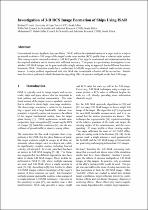JavaScript is disabled for your browser. Some features of this site may not work without it.
- ResearchSpace
- →
- Research Publications/Outputs
- →
- Conference Publications
- →
- View Item
| dc.contributor.author |
Lord, RT

|
|
| dc.contributor.author |
Nel, Willem AJ

|
|
| dc.contributor.author |
Abdul Gaffar, MY

|
|
| dc.date.accessioned | 2007-08-02T12:54:48Z | |
| dc.date.available | 2007-08-02T12:54:48Z | |
| dc.date.issued | 2006-05 | |
| dc.identifier.citation | Lord, RT, Nel, WAJ and Abdul Gaffar, MY. 2006. Investigation of 3-D RCS Image formation of ships using ISAR. 6th European Conference on Synthetic Aperture Radar, EUSAR 2006, International Congress Centre, Dresden, pp 4 | en |
| dc.identifier.uri | http://hdl.handle.net/10204/1071 | |
| dc.description.abstract | Conventional Inverse Synthetic Aperture Radar (ISAR) utilises the rotational motion of a target such as a ship or an aircraft to obtain a 2-D image of the target’s radar cross section (RCS) profile from a coherent radar system. This concept can be extended to obtain a 3-D RCS profile if the target's translational and rotational motion has the required attributes and is known with sufficient accuracy. This paper is a preliminary investigation to see whether 3-D ISAR images can be generated with a single antenna, using an approach that is different from inter-ferometric ISAR. Simulation results have verified that 3-D ISAR images can be obtained under certain circum-stances. A major problem experienced with ship ISAR data is multipath reflection off the sea surface. Simula-tions have been performed, which illustrate the degrading effect of specular multipath on the final 3-D image. | en |
| dc.language.iso | en | en |
| dc.subject | Image formation | en |
| dc.subject | ISAR | en |
| dc.subject | Inverse synthetic aperture radar | en |
| dc.title | Investigation of 3-D RCS Image formation of ships using ISAR | en |
| dc.type | Conference Presentation | en |
| dc.identifier.apacitation | Lord, R., Nel, W., & Abdul Gaffar, M. (2006). Investigation of 3-D RCS Image formation of ships using ISAR. http://hdl.handle.net/10204/1071 | en_ZA |
| dc.identifier.chicagocitation | Lord, RT, WAJ Nel, and MY Abdul Gaffar. "Investigation of 3-D RCS Image formation of ships using ISAR." (2006): http://hdl.handle.net/10204/1071 | en_ZA |
| dc.identifier.vancouvercitation | Lord R, Nel W, Abdul Gaffar M, Investigation of 3-D RCS Image formation of ships using ISAR; 2006. http://hdl.handle.net/10204/1071 . | en_ZA |
| dc.identifier.ris | TY - Conference Presentation AU - Lord, RT AU - Nel, WAJ AU - Abdul Gaffar, MY AB - Conventional Inverse Synthetic Aperture Radar (ISAR) utilises the rotational motion of a target such as a ship or an aircraft to obtain a 2-D image of the target’s radar cross section (RCS) profile from a coherent radar system. This concept can be extended to obtain a 3-D RCS profile if the target's translational and rotational motion has the required attributes and is known with sufficient accuracy. This paper is a preliminary investigation to see whether 3-D ISAR images can be generated with a single antenna, using an approach that is different from inter-ferometric ISAR. Simulation results have verified that 3-D ISAR images can be obtained under certain circum-stances. A major problem experienced with ship ISAR data is multipath reflection off the sea surface. Simula-tions have been performed, which illustrate the degrading effect of specular multipath on the final 3-D image. DA - 2006-05 DB - ResearchSpace DP - CSIR KW - Image formation KW - ISAR KW - Inverse synthetic aperture radar LK - https://researchspace.csir.co.za PY - 2006 T1 - Investigation of 3-D RCS Image formation of ships using ISAR TI - Investigation of 3-D RCS Image formation of ships using ISAR UR - http://hdl.handle.net/10204/1071 ER - | en_ZA |






